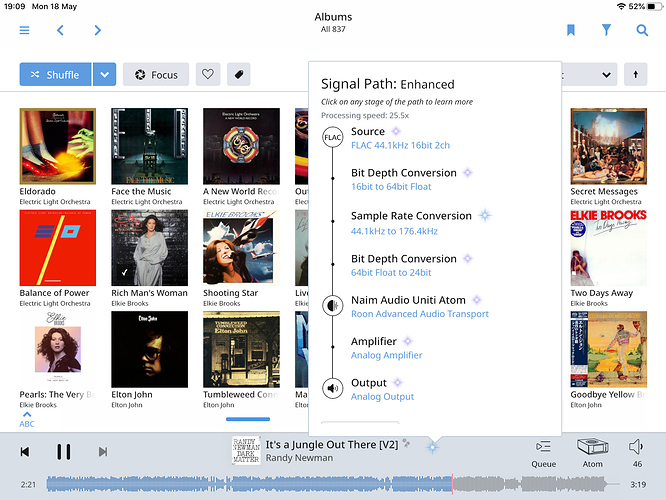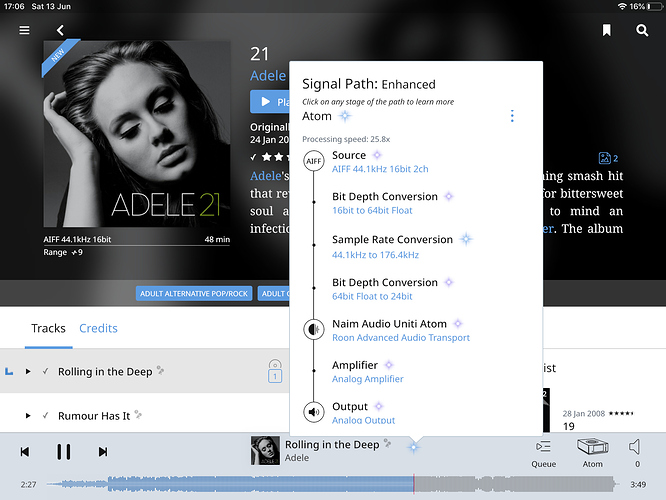Another cheapo experiment bears fruit.
Once again, being the tight arse that I am, I thought I would try another experiment, ideally, without spending money. Almost managed it this time but I had to put a couple of bob in the meter.
Anyway, down to business.
Up until now I have been happy (?) with using FLAC files through Roon RAAT, through all the networking gizmos into the Atom. Playing around, I thought I would take a chance on changing the file format to AIFF. What’s the point when RAAT converts everything to PCM anyway.
Onwards and upwards, I converted a couple of well liked Albums to AIFF and added them to Roon. Played them back and liked what I heard. Doing a direct comparison to FLAC, switching between them as fast as my podgy fingers would allow, I was surprised at the difference … for the better. In particular, acoustic instruments seemed to have more texture, bass seemed deeper and tighter (?).
Why should this be so? No settings in Roon were changed and there was little difference in the amount of processing going on within Roon. Using the Roon signal path monitor as a guide, I was still getting around 25x. I have upsampling enabled but as I said previously, no settings were changed.
So now, I have converted my entire library to AIFF and added that to Roon. I’ll see how it goes but so far, I’m all in.
Unless there’s an error somewhere along the chain, it’s impossible there’s a physical difference. But if you’re happier, go for it!
To compare properly you need a methos of seamlessy switching not stop staring files. I suggest a better method is to use Audacity on a pc and connect to a DAC and use headphones to compare. Audacity allows swithcing tracks without any glitches or delay. I will be surprised if you hear anything this way. Comparing with stopping starting tracks is just not accurate as your relying on memory and playing different parts of the songs. I did this when compariing rips from a Melco Ripper vs ones from USB drive on a mac and DB PowerAmp they sounded the same using this method. Our ears a lfawed when doing time delayed A/B Comparions. But if you happy it matters not.
Just done it with an album I purchased as WAV and converted to FLAC o converted WAV to AIFF, they all sound exactlty the same. I also have a Naim Atom and notice no difference there either.
Would you mind posting your signal path? Is your DAC wired directly on the core?
There is certainly a difference:
And also: http://www.positive-feedback.com/Issue63/aiff.htm
How much one will notice will depend on factors such as their playback system and their own hearing.
Certainly not.
If you’re using Roon in the recommended configuration, that is Core on a server away from your listening location and sending audio over the network via RAAT to an endpoint, then the data arriving at the endpoint is unchanged from any of the file formats referenced by OP.
Upsampling should be the same as well but it would be interesting if you redid the testing with upsampling off. Maybe, potentially, there could be impact on the unpacking influending the upsample operation. If there is a difference in upsampling you’d then want to upsample offline and remove doing it in real time. That is, compare an upsampled file vs. letting Roon do it on the fly. Upsampling filters would need to be the same and that’s not always possible however.
I love how both sides just jump into their pre-prepared trenches at the slightest hint of these debates. How about we just discuss the possibilities?
I’m very much a skeptic on this point. Except when I don’t care, my endpoints are always separate from the core. I subscribe to and completely understand the philosophy behind that. And I have heard noise out of cheaper DACs connected to electrically noisy computers.
So let’s just ask the question: how is your audio chain configured?
Roon core ROCK- ethernet - Nuc de3815 ROCK endpoint - usb - RME DAC, Meze 99 Classics
Roon core ROCK- ethernet, Untii Atom, Meze 99 Classics.
Audacity on Windows Surface Laptop waspai exclusive mode to RME DAC, Meze 99 Classics , so I can seemlessly switch between the sources.
No DSP tried flac, wav and Aiff all sounded the same in all scenarios.
I’ve never used a Uniti Atom. How does a Roon Core connect to that - is it ethernet or USB?
This is a quote of a post from the Steve Hoffman forum. I don’t know this gentleman, but here’s his observation.
"I don’t know about AIFF, but when I did audio testing for a living, I did a bunch of comparisons between WAV and FLAC. This was over ten years ago, I think FLAC was still in beta, and even then, when captured and analyzed coming out of a S/PDIF stream on an, for the time, old machine:
- The datastream was exactly the same
- Timing/jitter was exactly the same
- All measurable audio characteristics were exactly the same (THD/IMD/spectral histogram, dynamic range, etc…)
I tested the files, going from WAV->FLAC->WAV for data integrity. I tested dumping the raw PCM to a file through a software loopback driver, and finally through a S/PDIF interface into an Audio Precision audio analyzer. Everything came back exactly the same, bit for bit. This was on an old Dell P3 running Windows XP, using the cheapest USB S/PDIF interface available at the time (M-Audio?) For the hell of it, we tested both RCA and TOSLINK into the Audio Precision - also no difference.
In short, there is absolutely no difference when playing back the two formats."
Since WAV and AIFF are both uncompressed formats, it seems likely FLAC and AIFF would have the same relationship.
Mine is connected via ethernet but there are digital coax and toslink options there if you need them.
Did he listen to the results?
I love that you take the time to compare, and that you also have a preference. This has been discussed since we started playing back music on our computers. I say, try!
If you like what you hear, fine, others will not. There will also always be those who tell you that do not hear what you think, because they cannot hear any differences.
And discussing whether any differences are “real” seem to have no end… 
Dont waste time trying to convince others, have an open mind and try it if the glove fits, but dont forget to enjoy the music! 
Ethernet it’s a Roon Ready all in one.
I would suggest that any differences the OP found are likely to be streaming device or DAC specific rather than inherent within the different lossless formats such as FLAC, AIFF, WAV etc.
Some time ago when I was first getting into streaming and had a Naim ND5XS streamer/DAC and long before I implemented Roon, I felt that there was a (subtle) difference between the sound of uncompressed FLAC files and transcoded WAV versions of the same files. To my ears, the WAV versions sounded subtly better - an opinion that was shared by most in the Naim community. This was confirmed for me when I conducted a ‘blind’ test with an audio engineer whose ears were younger and presumably better than mine. He was able to score virtually 100% in recognizing which tracks were played from a FLAC or WAV source, and like me thought that the sound WAV files sounded slightly better. He had a full Linn system at his home, and wasn’t able to replicate the results on his own system.
Because of this, and while I had the Naim streamer, I used to transcode FLAC to WAV on the fly when playing files stored on my local Synology NAS.
I sold my Naim streamer many years ago and now run two main systems: a 2nd gen Linn Klimax in one, and a Sonore microRendu/Mytek Brooklyn DAC+ in the other. I cannot detect any difference whatsoever between WAV and FLAC files played on either of these systems.
Interestingly, many Naim users who have upgraded to the most recent versions of their streamers now post that there is no longer any significant (if any) difference between FLAC or WAV files played through the new range of streamers.
OK, thanks for your response.
Well, in theory this difference you hear is "impossible’ and I subscribe to that point, at least until a plausible explanation is offered.
I am definitely not saying you are not hearing a difference. But that I cannot explain why and that it doesn’t make scientific/engineering sense, because what you are saying is that the digital bits that leave your core and travel to the Naim via network are different from FLAC to AIFF, when both files contain identical information. The network should eliminate any electrical processing noise or such, and the difference anyway should be less noise, not “deeper bass.”
I don’t even see how it could be device specific at the endpoint. I’d love to see someone with the right equipment - say a digital output on the endpoint that can be fed into a computer or another measuring device - try measuring the differences AT THE ENDPOINT and see what they get. Separate endpoints are a core (get it?) philosophy of the Roon configuration, and these claims merit exploration, albeit my expectation bias expects no difference.
AIFF/WaveB are best sounding as they are flat files, meaning they can be read and sent to the dac as is and require no manipulation of data. ALAC/FLAC files are loss less, but are like zip files and require unpacking which will increase the processing up to 30% which will impact the sound of your system.
-Gordon Rankin (essentially one of the inventors of asynchronous USB audio), from https://www.usbdacs.com/Setup/

